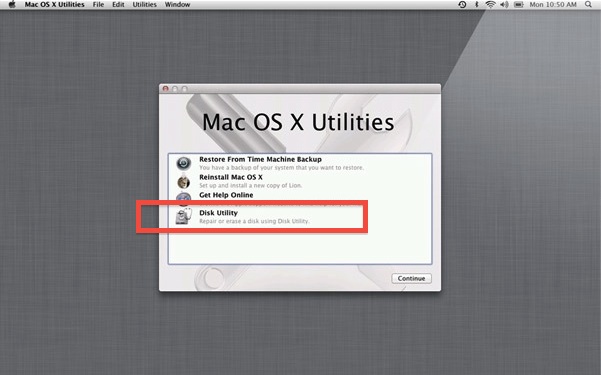Reinstall from macOS Recovery
- Click on your Mac's startup drive in the Disk Utility sidebar. It should be the drive at the top of the sidebar if there are multiple drives. Click First Aid. First Aid will run, checking the health of your Mac's drive. This process could take a little while. Click Disk Utility in the Menu bar. Click Quit Disk Utility.
- From the OSX utilities screen I tried restore from Time Machine and it searched for disks but it could not find the destination to restore the system. I then tried reinstall Mountain Lion from the utilities screen but could not get any further. I tried disk repair but my Mac HD is not shown only the hard disk that I back up using Time.
- Grab, the built-in Mac OS X service that captures screenshots, might be sufficient for most people. If you're looking to pair an upload service to it, you can just add the great and free Cloud App.

When you open it, Terminal presents you with a white text screen, logged in with your OS X user account by default. Here's the important part: With a system administrator account and password, you have direct access to tweaking almost everything about your computer's software code; that means that while this little window provides great power. Screen Utility consists of 3 can't-miss features; Pixel Test, Screenshot Helper, and Capture Screen with Cursor.1) Pixel Test Pixel Test will help you find. Free SquidMelon Mac OS X 10.6/10.7.
Forecast bar 2 5 3 download free. macOS Recovery makes it easy to reinstall the Mac operating system, even if you need to erase your startup disk first. All you need is a connection to the internet. If a wireless network is available, you can choose it from the Wi-Fi menu , which is also available in macOS Recovery.
1. Start up from macOS Recovery
To start up from macOS Recovery, turn on your Mac and immediately press and hold one of the following sets of keys on your keyboard. Release the keys when you see an Apple logo, spinning globe or other startup screen.
Command (⌘)-R
Reinstall the latest macOS that was installed on your Mac (recommended).
Option-⌘-R
Deep freeze 7 2000. Upgrade to the latest macOS that is compatible with your Mac.
Shift-Option-⌘-R
Reinstall the macOS that came with your Mac, or the closest version that's still available.
You may be prompted to enter a password, such as a firmware password or the password of a user who is an administrator of this Mac. Enter the requested password to continue.
When you see the utilities window, you have started up from macOS Recovery.
2. Decide whether to erase (format) your disk
You probably don't need to erase, unless you're selling, trading in or giving away your Mac, or you have an issue that requires you to erase. If you need to erase before installing macOS, select Disk Utility from the Utilities window, then click Continue. Find out more about when and how to erase.
3. Install macOS
When you're ready to reinstall macOS, choose Reinstall macOS from the Utilities window. Then click Continue and follow the on-screen instructions. Iconjar 2 2 0 5. You will be asked to choose a disk on which to install.
- If the installer asks to unlock your disk, enter the password you use to log in to your Mac.
- If the installer can't see your disk, or it says that it can't install on your computer or volume, you might need to erase your disk first.
- If the installer is for a different version of macOS than you expected, learn about macOS Recovery exceptions.
- If the installer offers you the choice between installing on Macintosh HD or Macintosh HD - Data, choose Macintosh HD.
Please allow the installation to be completed without putting your Mac to sleep or closing its lid. During installation, your Mac may restart and display a progress bar several times, and the screen may be blank for minutes at a time.
Screen Utility Mac Os Recovery Tool
If your Mac restarts to a setup assistant, but you're selling, trading in or giving away your Mac, press Command-Q to quit the assistant without completing the setup process. Then click Shut Down. When the new owner starts up the Mac, they can use their own information to complete the setup process.
macOS Recovery exceptions
The version of macOS offered by macOS Recovery may vary in some cases:
Mac Os Screenshot
- If macOS Sierra 10.12.4 or later has never been installed on this Mac, Option-Command-R installs the macOS that came with your Mac, or the closest version that's still available. And Shift-Option-Command-R isn't available.
- If you erased your entire disk instead of just the startup volume on that disk, macOS Recovery may offer only the macOS that came with your Mac, or the closest version still available. You can upgrade to a later version later.
- If your Mac has the Apple T2 Security Chip and you never installed a macOS update, Option-Command-R installs the latest macOS that was installed on your Mac.
- If you've just had your Mac logic board replaced during a repair, macOS Recovery may only offer the latest macOS that is compatible with your Mac.
If you can't get macOS Recovery to offer the installer you want, you may be able to use one of the other ways to install macOS. Wolf 1 41 – build responsive web sites.
Other ways to install macOS
Mac Os Utility
- You can also install macOS from the App Store or Software Update preferences. If you can't install macOS Catalina, you might be able to install an earlier macOS, such as macOS Mojave, High Sierra, Sierra, El Capitan or Yosemite.
- Or, create a bootable installer disk, then use that disk to install macOS on your Mac or another Mac.
